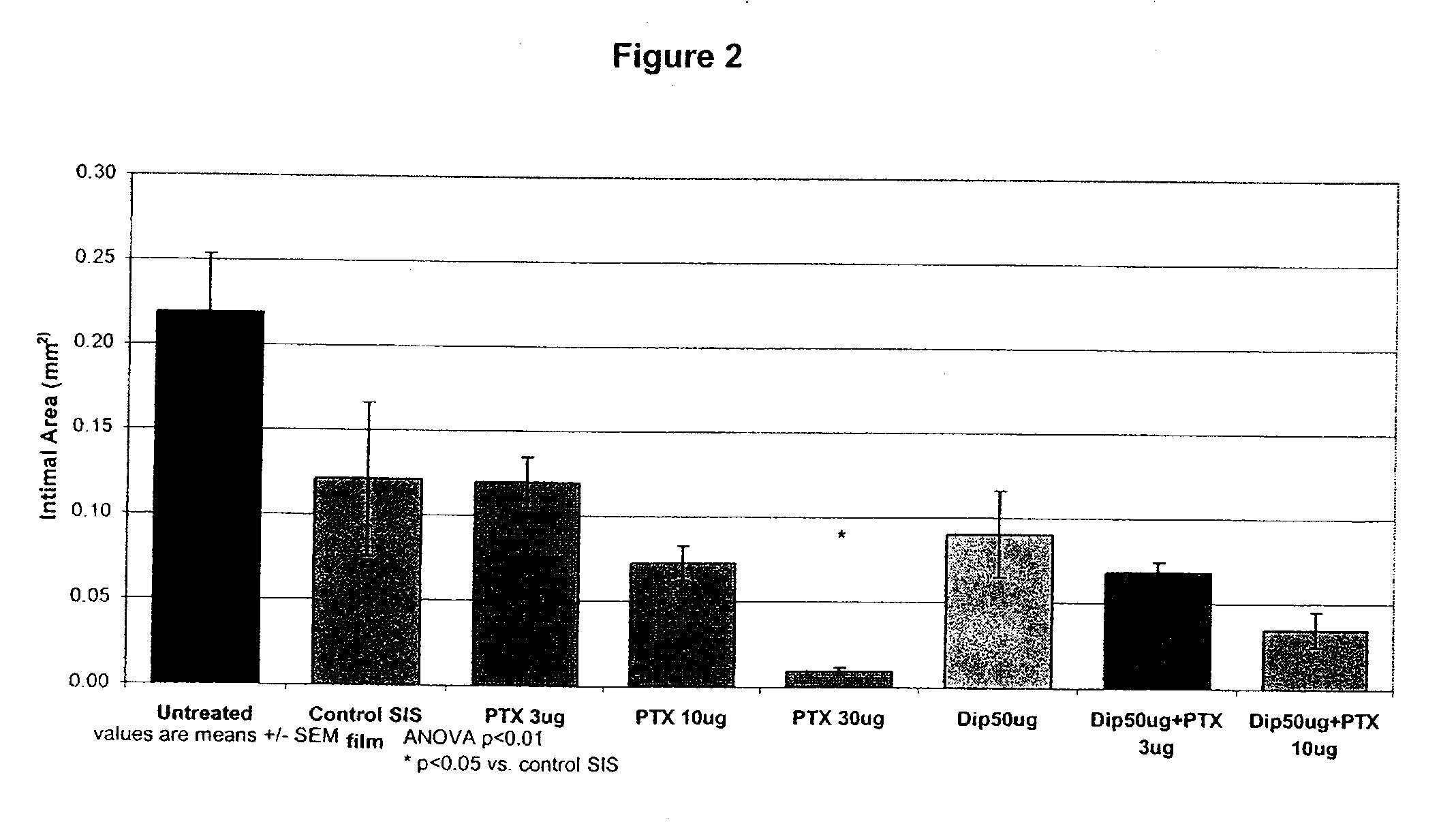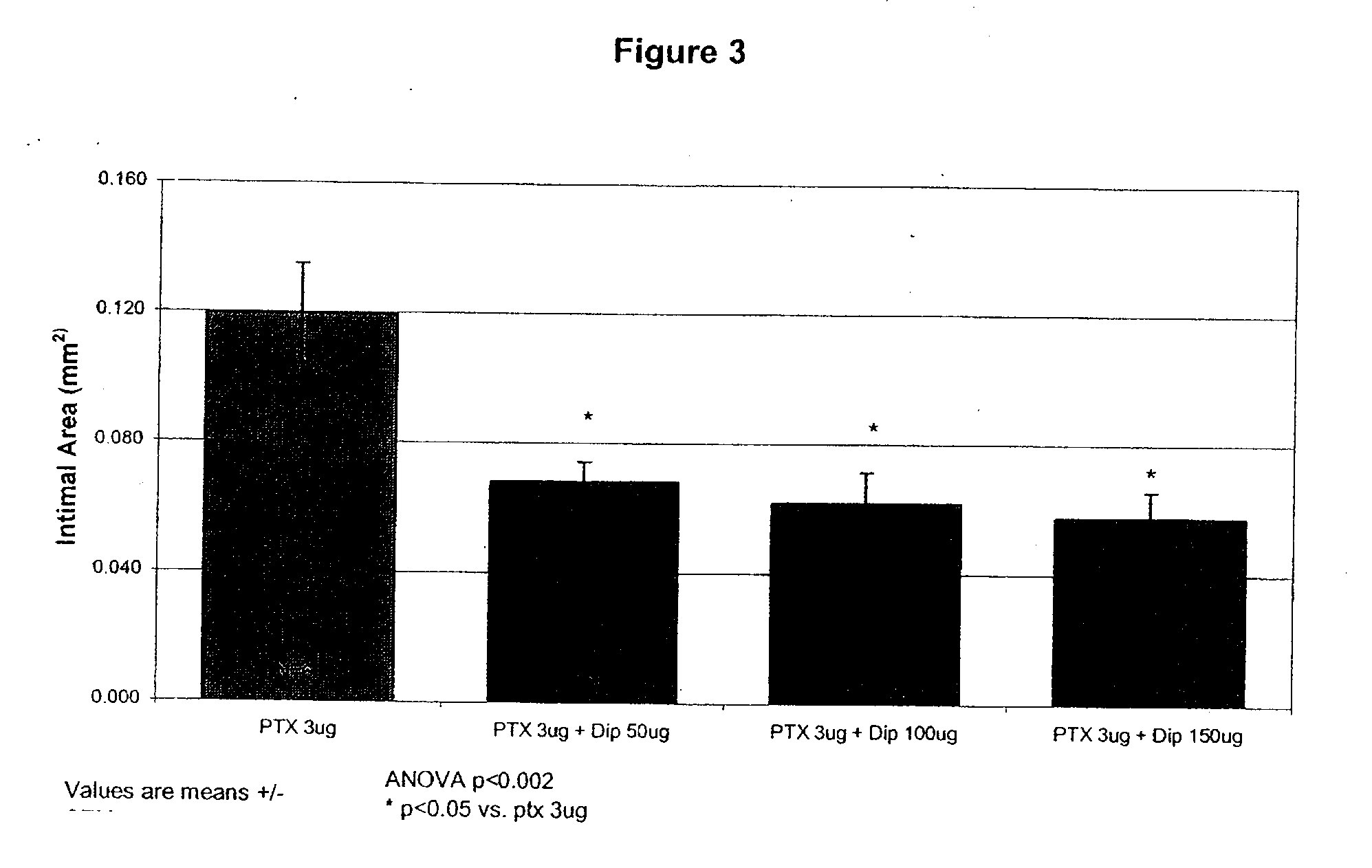Medical implants with a combination of compounds
a technology of compound and medical implants, applied in the field of pharmaceutical compositions, medical devices, combinations, can solve the problems of limiting the effectiveness of invasive treatments for a variety of diseases, stenosis (or narrowing), and many devices implanted in the body are subject to a “foreign body” response, so as to minimize the formation of neointimal hyperplasia
- Summary
- Abstract
- Description
- Claims
- Application Information
AI Technical Summary
Benefits of technology
Problems solved by technology
Method used
Image
Examples
example 1
Coating Solutions
[0476]Stainless steel stents (Pulse Systems, Inc., Concord, Calif.) were plasma treated and then spray coated with the following primer solution and dried in an oven for 30 minutes at 125-130° C. The coating and drying procedure was repeated a second time.
Coating Solution AComponentAmount (grams)Ethylene acrylic acid copolymer1.68Tetrahydrofuran (THF)15.54Dimethyl acetamide (DMAC)19.87Anisole21.27Xylenes41.34Epoxy resin0.33
[0477]The devices were then spray coated with the following solution and dried in an oven at 125-130° C. for 30 minutes. The coating and drying procedure was repeated a second time to form an intermediate (tie layer).
Coating Solution BComponentAmount (grams)Aromatic polycarbonate-based polyurethane11.03solution (22-25% by weight in DMAC)Dimethyl acetamide (DMAC)0.27Anisole20.22Methyl isobutyl ketone (MIBK)68.48
[0478]Paclitaxel and dipyridamole were added to polymer stock solutions in various amounts to produce the following coating solutions.
Coati...
example 2
More Coating Solutions
[0480]Stainless steel stents (Pulse Systems, Inc., Concord, Calif.) were plasma treated and then spray coated with the following primer solution and dried in an oven for 30 minutes at 125-130° C. The coating and drying procedure was repeated a second time.
Coating Solution FComponentAmount (grams)Styrene-isobutylene-styrene copolymer1.00Ethylene acrylic acid copolymer1.66Tetrahydrofuran (THF)15.38Dimethyl acetamide (DMAC)19.67Anisole21.06Xylenes40.93Epoxy resin0.33
[0481]The devices were then spray coated with the following solution and dried in an oven at 125-130° C. for 30 minutes. The solution was re-applied and dried for 60 minutes to form an intermediate (tie layer).
Coating Solution GComponentAmount (grams)Styrene-isobutylene-styrene copolymer3.50Toluene91.55THF4.95
[0482]The devices were then spray coated with the one of the following polymer solutions and dried in an oven for 30 minutes at 75±5° C. The process was repeated to obtain the desired compound loa...
example 3
Procedure for Producing SIS Films
[0483]Paclitaxel, dipyridamole, or a combination of paclitaxel and dipyridamole were incorporated into styrene-isoprene-styrene (SIS) polymeric films. Two grams (2 g) of styrene-isoprene-styrene polymer (Mn=150K dalton / mole by GPC relatively to PS standard, Sigma-Aldrich) was dissolved in 10 mL tetrahydrofuran to achieve a 20% w / v solution and loaded with various amounts of paclitaxel and / or dipyridamole. The drug loaded solutions were cast into a film (50×130 mm2) and the film was dried under nitrogen for 1 hour at room temperature and then at 40° C. in a forced-air oven for 2 hours. The film was further vacuum-dried for 16 hours at room temperature. The final film was cut into 8 mm×8 mm using a die cutter. The films had a thickness of about 55-60 μm. Films having the following amounts of paclitaxel and dipyridamole were prepared: paclitaxel (3, 10, 30 μg); dipyridamole (50 μg); dipyridamole / paclitaxel (50 / 3 μg; 50 / 10 μg; 100 / 3 μg; 150 / 3 μg; and 150...
PUM
| Property | Measurement | Unit |
|---|---|---|
| Mass | aaaaa | aaaaa |
| Mass | aaaaa | aaaaa |
| Mass | aaaaa | aaaaa |
Abstract
Description
Claims
Application Information
 Login to View More
Login to View More - R&D
- Intellectual Property
- Life Sciences
- Materials
- Tech Scout
- Unparalleled Data Quality
- Higher Quality Content
- 60% Fewer Hallucinations
Browse by: Latest US Patents, China's latest patents, Technical Efficacy Thesaurus, Application Domain, Technology Topic, Popular Technical Reports.
© 2025 PatSnap. All rights reserved.Legal|Privacy policy|Modern Slavery Act Transparency Statement|Sitemap|About US| Contact US: help@patsnap.com



